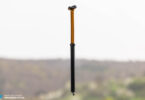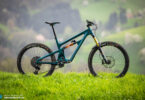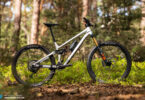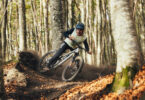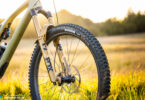With something of a cult following for their excellent titanium and steel hardtails, UK brand Stanton’s new 160 / 140 mm Switch9er FS combines steel and aluminium to produce an engineering enigma. Does this pairing make for the best of both worlds on the trails?
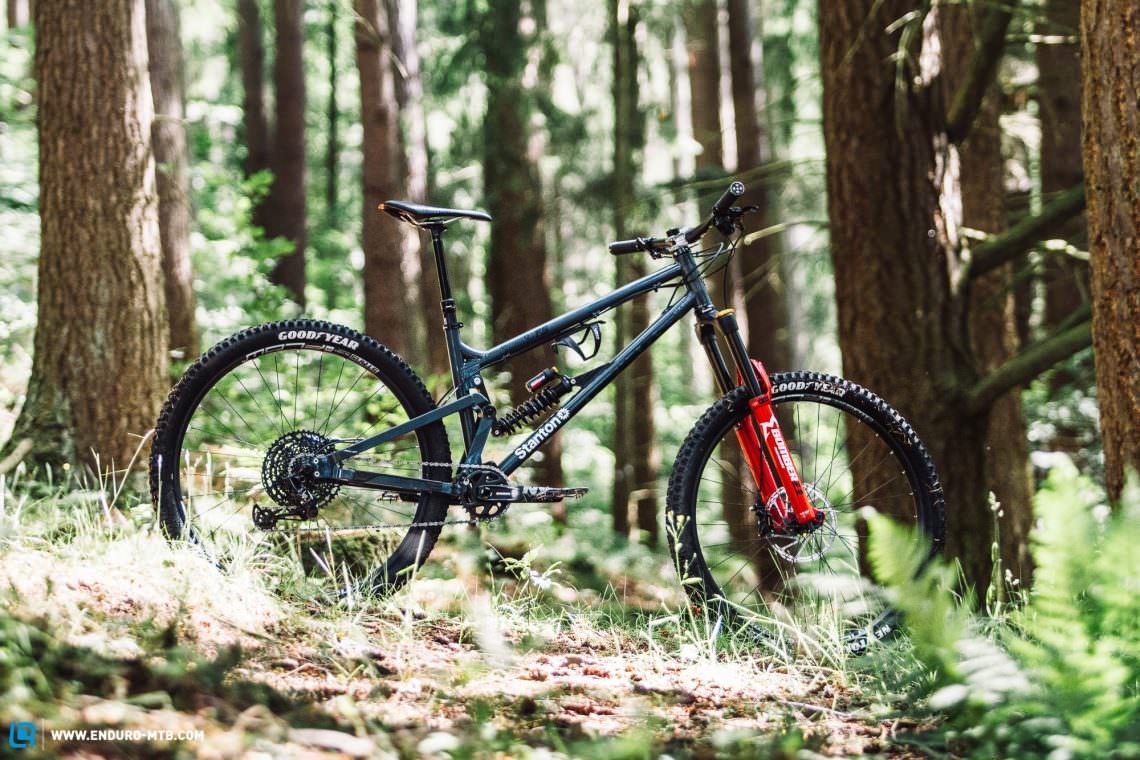
Aluminium and steel. Why mix metals?
Steel full-suspension bikes are nothing new. There are several on the market with their distinctive slim stays and skinny silhouette. However, the 29-inch wheeled Stanton Switch9er FS does things differently and uniquely so. Stanton are openly obsessive about lateral stiffness for increased pedalling efficiency and this is just as important to ensure suspension components and pivots are loaded in the right direction and don’t suffer excessive wear. Stanton have used the same Reynolds 631 front triangle as used in its group test winning hardtails. That has been paired with a rear end constructed with 6063-T6 stays which form the two individual sides of the rear triangle. The aluminium construction means the rear end can be designed to be both stiff and lightweight, minimising unsprung weight and further maximising lateral stiffness. The two one-piece sections are connected to each other with two CNCed 6082-T6 suspension linkages, which in turn connect to the CNCed steel top pivot and ‘The Egg’ bottom bracket/lower pivot in the main triangle. There’s a lot of engineering design in this frame!
While the use of both steel and aluminium has some interesting engineering applications, we also love the balanced aesthetic.
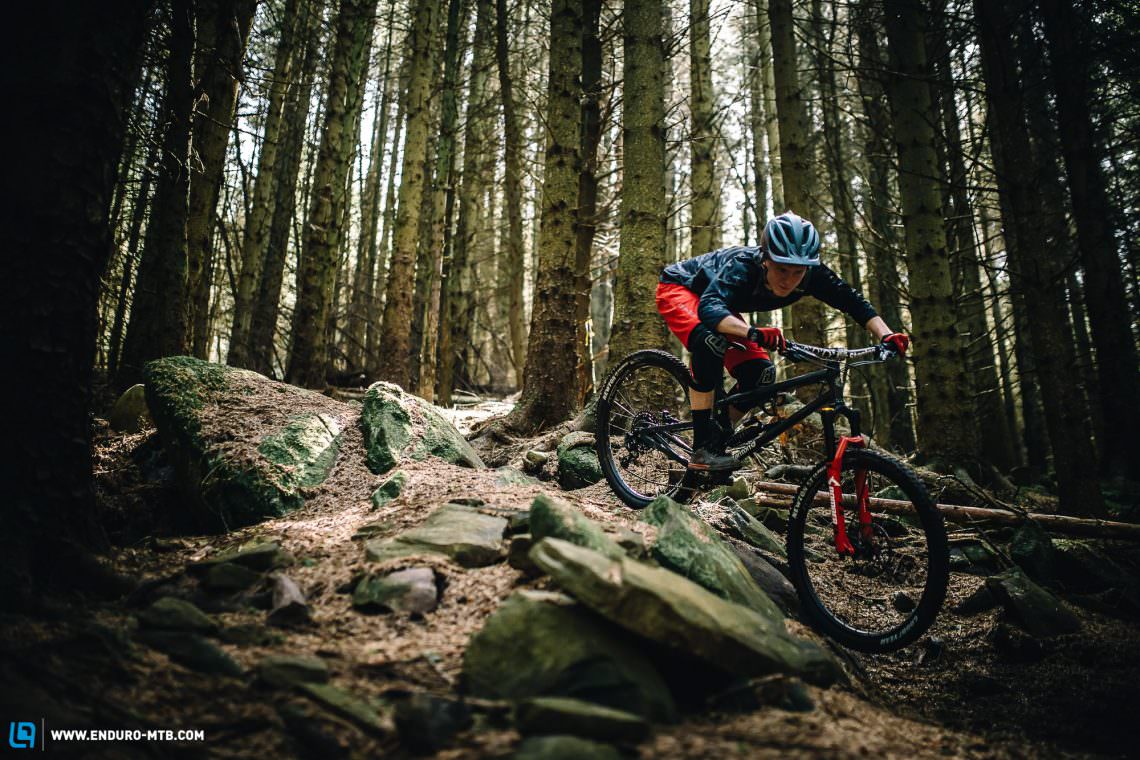
Suspension design of the Stanton Switch9er FS
The Stanton Switch9er has 140 mm of rear travel and utilises a twin-link suspension design. In the hands of a capable designer, this arguably offers the most control to tune the many different suspension parameters. Stanton has engineered in an extremely progressive leverage curve, which drops from 2.5:1 to around 1:1. This low final leverage ratio reduces the forces acting on the shock and improves consistency and reliability. Stanton has engineered in a high level of anti-squat – approximately 150% – around the sag point. Chain forces fall away rapidly as the bike works through its travel to help control pedal kickback which is kept relatively low. Following a popular trend, the shock is mounted parallel to the downtube to help direct the forces along the tubing but more importantly, also provides space for a water bottle.
Stanton Switch9er FS geometry
The Stanton Switch9er FS is available with custom geometry, so if, for example, you want a 16.5″ seat tube with the reach of an 18.5″ frame, that’s no problem thanks to Stanton’s in-house manufacturing. As such, we will only focus on the critical points of the standard sizes. Overall the sizing is representative of the latest generation of enduro bikes, with 470 mm reach in size Large and a 76° seat tube angle. However, the slack 63.7° head angle will raise a few eyebrows, and the 1265 mm wheelbase and tall 632 mm stack is at the extreme end of the scale. The long front triangle is balanced with lengthy 445 mm chainstays, but the measurement that particularly caught our attention was the 14 mm bottom bracket drop – around 15 mm higher than most similar bikes.
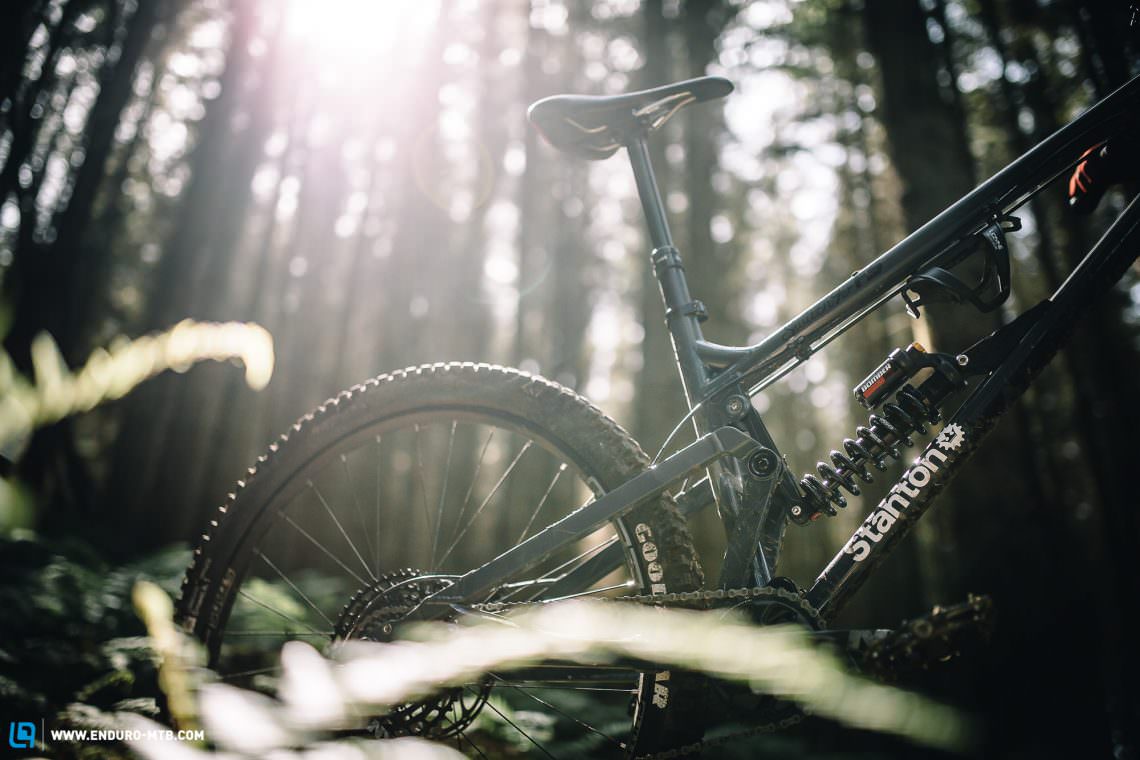
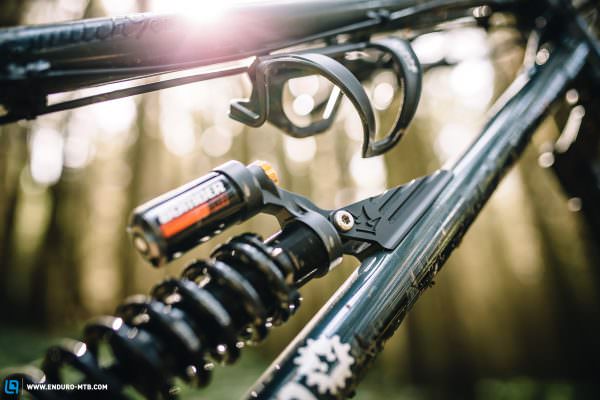
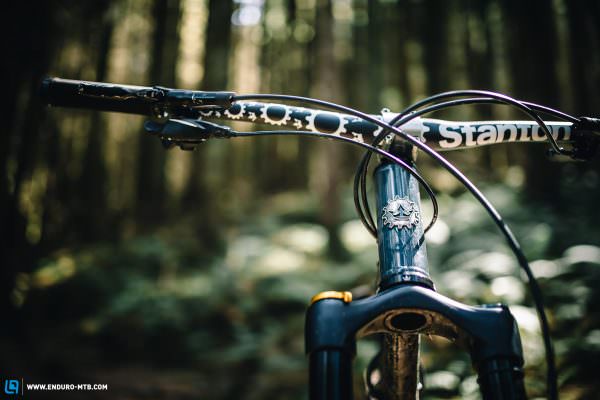
Bucking convention with a higher bottom bracket
We are seeing 29ers coming with BBs so low that they may as well be touching the ground. That might be a bit of an exaggeration but Stanton has definitely ignored this trend with their Switch9er FS, with a relatively small 14 mm BB drop. Speaking to Dan Stanton he explained, “You can slacken and lengthen a 29er to increase the stability, but if you also throw in a deep BB, it creates a pendulum feel in turns, making it harder to lean over. In my testing, if you raise the BB but keep all the other factors that increase stability, it helps when you are cutting through turns.” This is interesting thinking, and not unique to just Stanton. Other brands designing slack 29ers such as Pole also use a relatively high BB.
Stanton Switch9er FS specification
The Stanton Switch9er FS is available as a frame only for £2,500 with either a Fox X2 Air or Ohlins TTX Coil shock. It is available in a vast range of colours thanks to Stanton’s custom in-house paint service. Two complete builds are available as well: the £3,975 Standard build with a Marzocchi Bomber Z1 fork, SRAM NX drivetrain, Stans Flow wheels, SRAM Guide RE brakes and a Marzocchi Bomber CR Coil shock, and the £ 5,500 Elite model with a Fox Factory 36 Grip 2 fork, Shimano XT 11-speed drivetrain, Stans Carbon wheels, Shimano XT brakes and a Fox X2 or Ohlins TTX Coil rear shock.
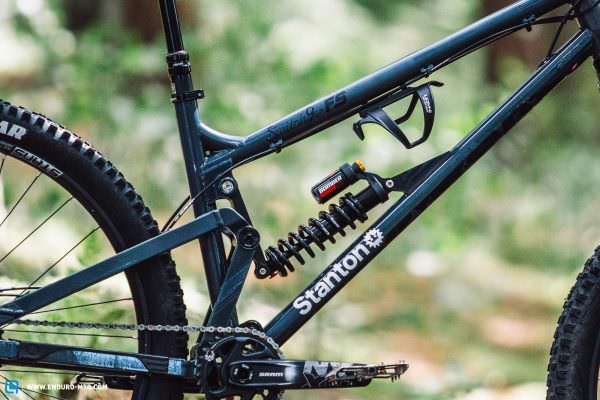
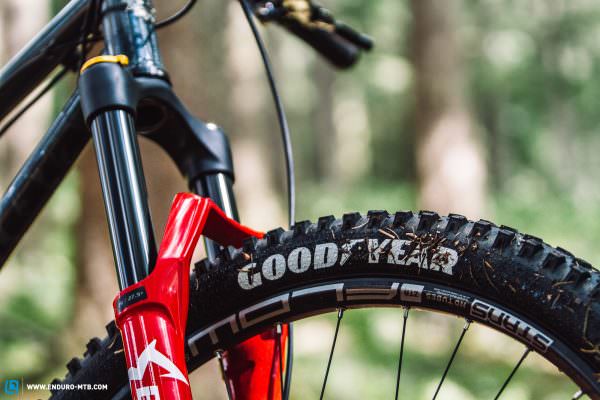
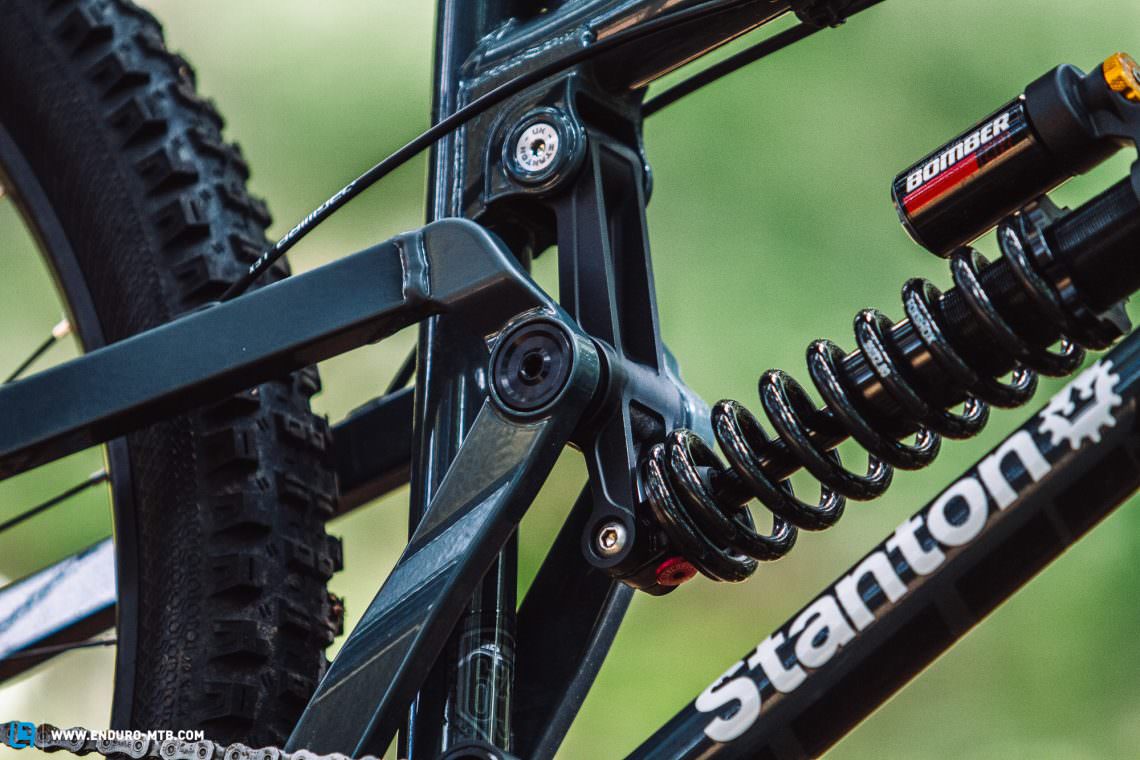
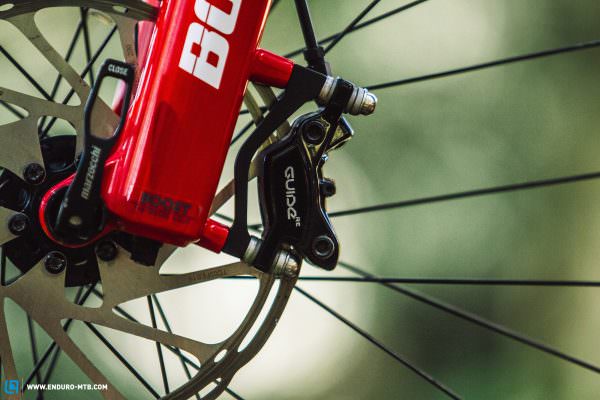
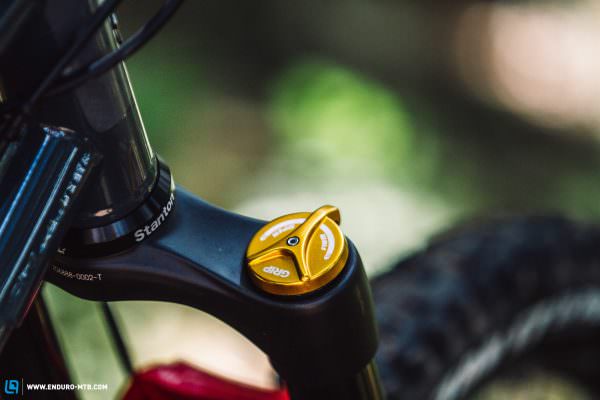
Riding the Stanton Switch9er FS
Our 180 cm tall tester chose to make full use of the Stanton custom geometry, choosing a Switch9er with the 419 mm seat tube length from the 16.5″ size frame married with the 470 mm reach of the 18″ bike. We tested the Standard spec bike for a week on our home trails on both steep and tech bike park style tracks and long natural climbing days.
Given Stanton’s expertise in hardtails, it’s perhaps no surprise to hear that the Switch9er FS has a focus on fast acceleration and efficient climbing. No sooner do you start spinning uphill on the Switch9er do you realise that Stanton has achieved this aim. It’s not a light bike by any means, but the high anti-squat ensures there’s no bob or unwanted movement in the suspension. Pedal efficiency is excellent and as soon as you put power through the pedals, the bike picks up and surges forward with enthusiasm. With its low standover, tall stack and 800 mm wide bars the down tube feels far beneath you and the bike offers you a lot of space. We’re big fans of longer chainstays and the 445 mm length balances out the long front centre and slack head angle well. While certainly too heavy to be considered rapid on the climbs, we were extremely impressed with the Switch9er FS’ eagerness to devour big hills with minimal fuss. Long days out are well within the bike’s comfort zone.
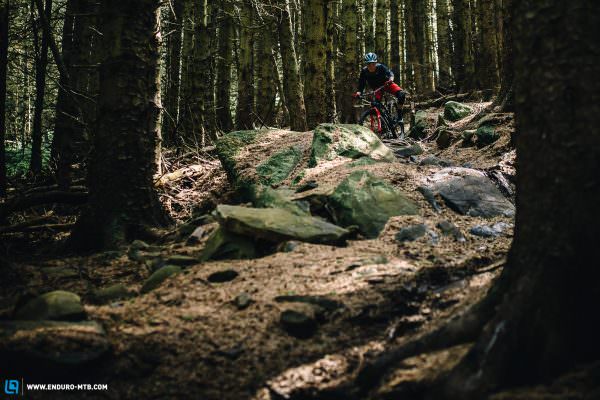
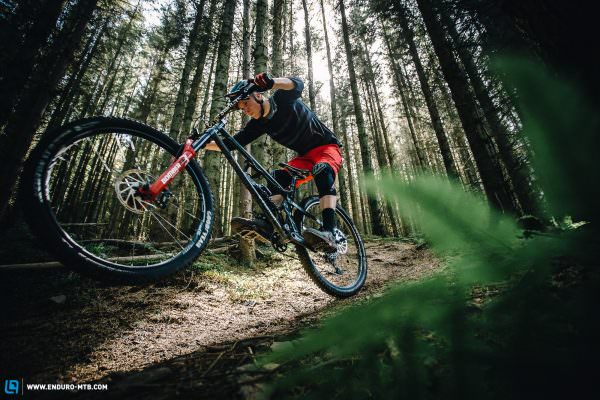
The Stanton Swith9er feels like a bike with big aspirations and we were interested to see how the mixed metal concept would perform when charging down trails that we know well. When the hits start to get bigger, you quickly notice the very progressive kinematics, which suit the Marzocchi Bomber CR Coil shock perfectly. Despite our most energetic flat-landings, the Switch9er refused to bottom-out harshly and even on downhill tracks we never felt held back by the 140 mm rear travel. High anti-squat bikes are often plagued by high levels of pedal kickback, but the Stanton Switch9er controls this well. Mid-travel support is huge, making the bike very playful indeed.
What impressed us most of all with the Stanton Switch9er is just how well put-together the overall package feels. There are no squeaks, creaks or rattles at all! It’s an engineer’s dream bike. Tight tolerances and innovative features such as the bracing provide a reassuring feeling of strength and solidity. Slapping hard into turns or aggressive cutties usually reveal flex and chatter but the Stanton remains resolutely solid. Charging over rock gardens, everything feels quiet and well-damped, with minimal vibrations running through the frame. How much of this is down to the naturally damped 631 steel front end or the exacting tolerances that Stanton work to is hard to pin down but it’s one of the quietest bikes we have ever ridden.
The higher BB feels less immersive in hard compressions and berms, but rewards with an engaging feel when flicking around and playing with the trail.
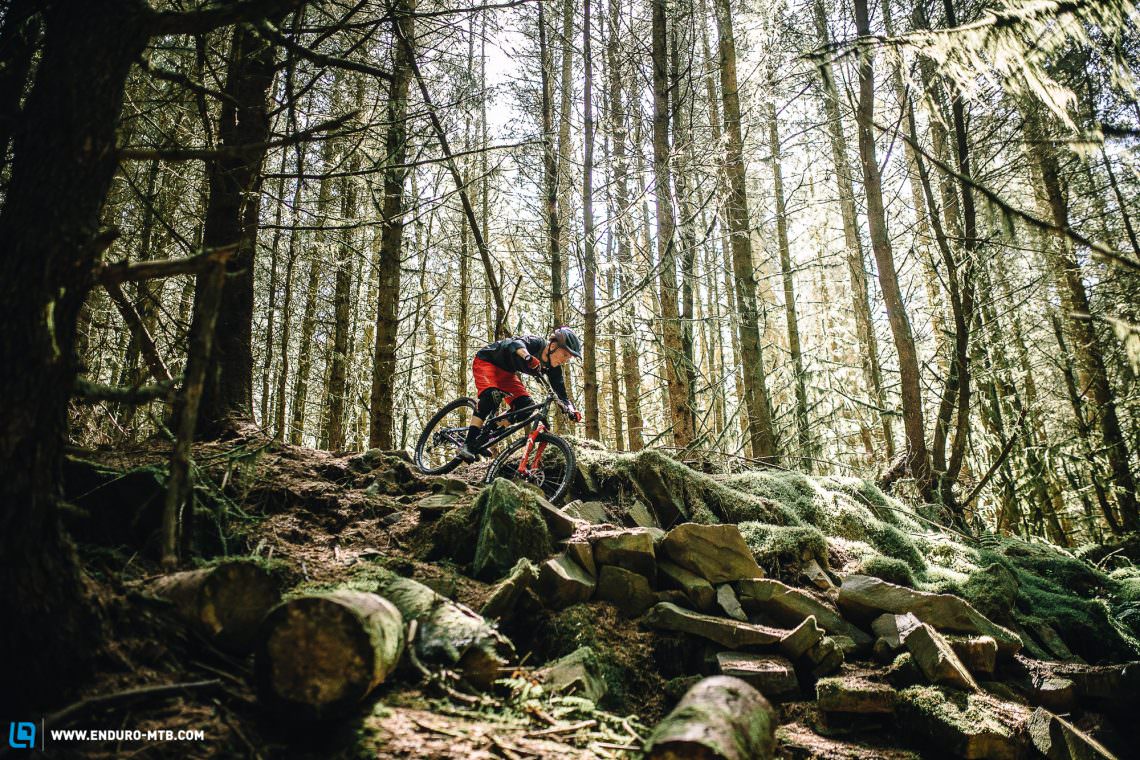
The standard build is all reliable and workhorse like kit, aside from the terrible Goodyear Newton tires which offer zero traction in the wet. No one can question the ride feel or heritage of the excellent Stans Flow wheels and the SRAM NX drivetrain does its job without any fuss. We are also huge fans of the SRAM Guide RE brakes but a 160 mm rear rotor has no place on a bike this fast. One feature that may prove to be polarising is the relatively high bottom bracket. Stanton claims that a higher BB makes the bike easier to lean over into the turns. On the trail this seems to hold some truth, as the Switch9er FS can be carved into flat turns quicker than we would expect from the 63.7° head angle bike, feeling more lively and engaging than the numbers would suggest. However, with geometry being a balance of compromises, changing one thing upsets things elsewhere at the same time. As such, the Switch9er FS lacks the ‘deep immersion between the axles’ feeling that you get with a super low BB. Combined with the tall stack, you do get a feeling of riding ‘on’ the bike rather than ‘in’ it, though this suits its playful nature and should not be considered a negative, just different. It won’t be for everyone but once you get used to how it rides, the Stanton hauls.
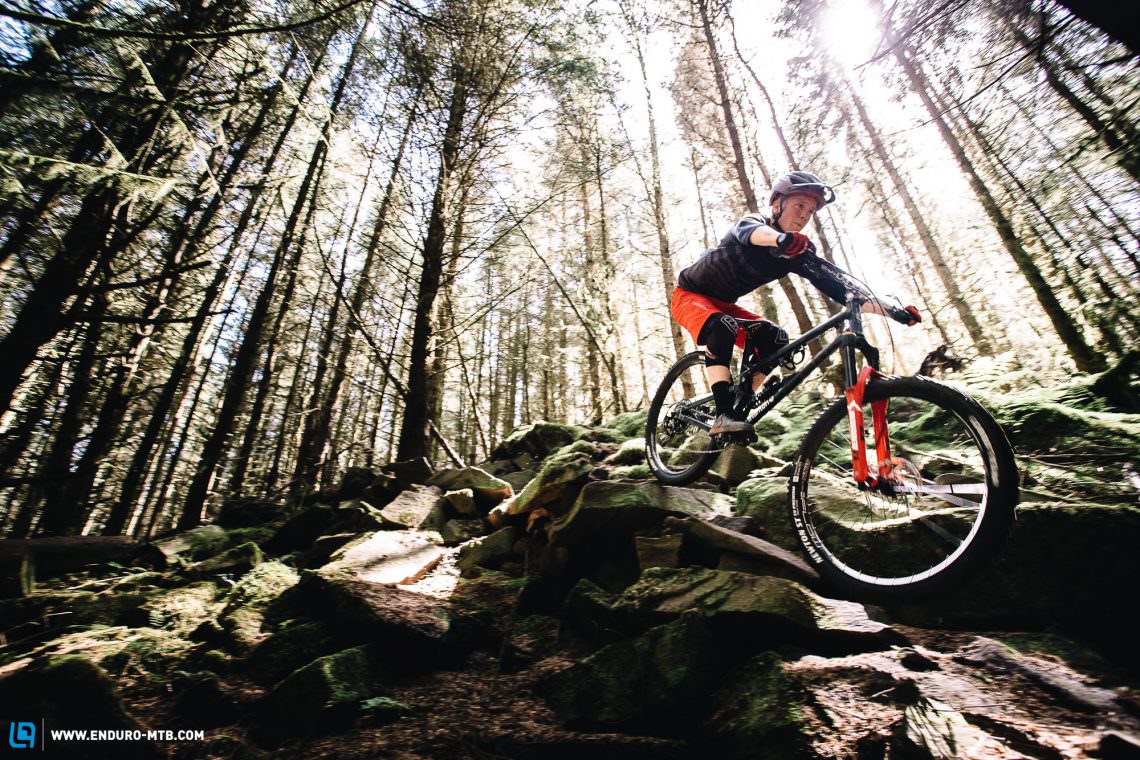
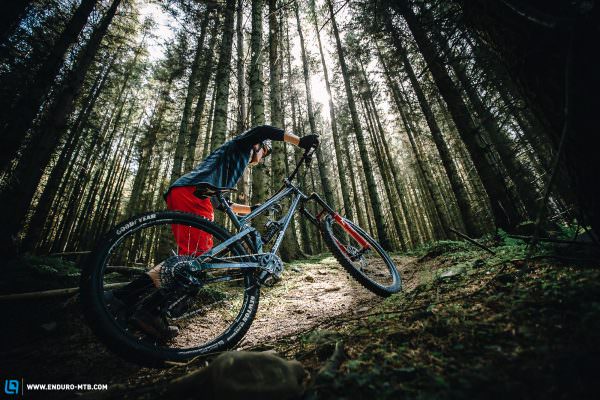
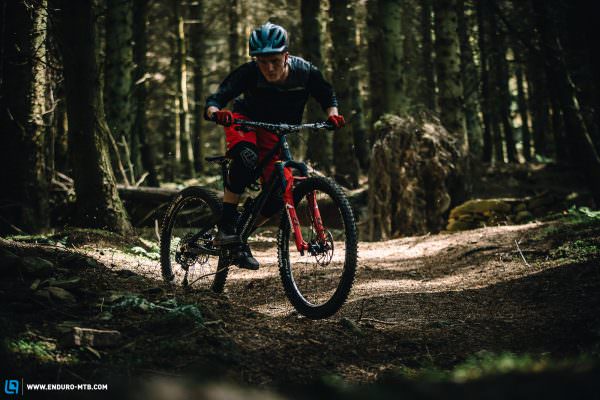
Downhill, the Stanton Switch9er feels bullet train fast, unstoppable and quiet – it’s a beautiful ride.
After a week of testing, we were impressed with the versatility of the Stanton Switch9er FS. With such laid-back angles, we were expecting a bit of a tank but instead got to enjoy a lively, energetic bike that did a great job on a variety of rides. For someone looking for a bike that will last more than a single model year and want a one-bike solution that will be happy to grind out a long epic in the saddle on Saturday before a day of uplifted DH fun on Sunday, the Stanton Switch9er FS makes an interesting and refreshing alternative to the mainstream brands. Beware: riding this bike will slow down your rides as people try to chat to you about its exciting engineering.
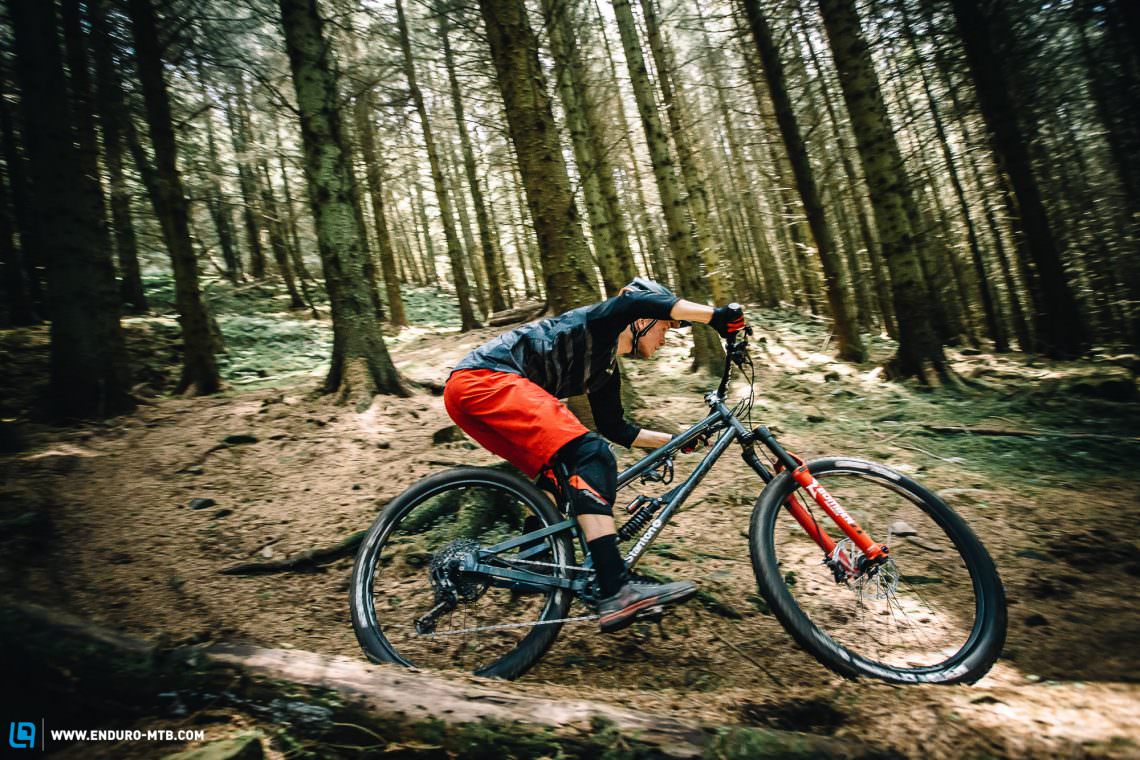
So how good is the Stanton Switch9er FS?
The Stanton Switch9er revealed itself to be a versatile do-it-all beast. The high levels of pedalling efficiency and truly progressive suspension give an energetic and playful ride that will delight active riders. The combination of steel and aluminium with intelligent engineering gives a feeling of unyielding stiffness and silent running that few bikes can match. If you’re looking for something different, we think you’ll enjoy every second.
Tops
- outstanding build quality
- playful and easy to throw around
- very versatile
Flops
- high BB reduces 'ride in' feeling
- a 160 mm rear rotor is too small
- it's no lightweight
For more info head to: stantonbikes.com
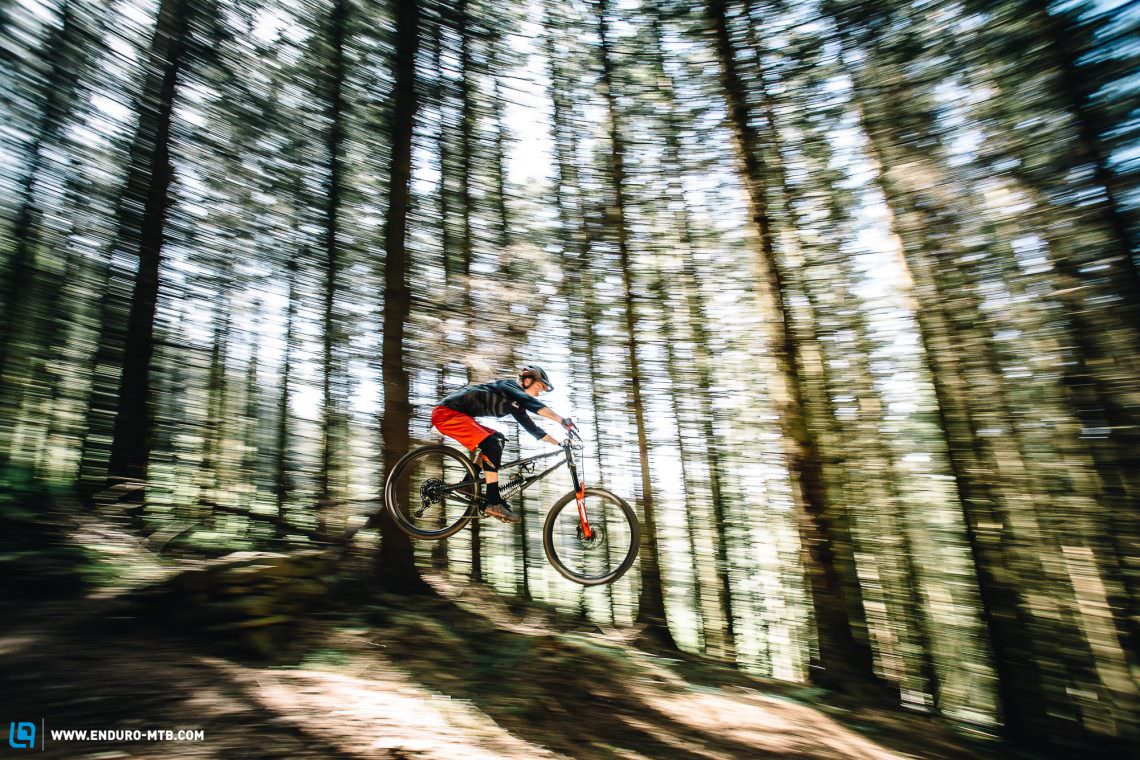
This article is from ENDURO issue #040
ENDURO Mountainbike Magazine is published in a digital app format in both English and German. Download the app for iOS or Android to read all articles on your tablet or smartphone. 100% free!


Did you enjoy this article? If so, we would be stoked if you decide to support us with a monthly contribution. By becoming a supporter of ENDURO, you will help secure a sustainable future for high-quality mountain bike journalism. Click here to learn more.
Words: Photos: Trevor Worsey, Finlay Anderson






